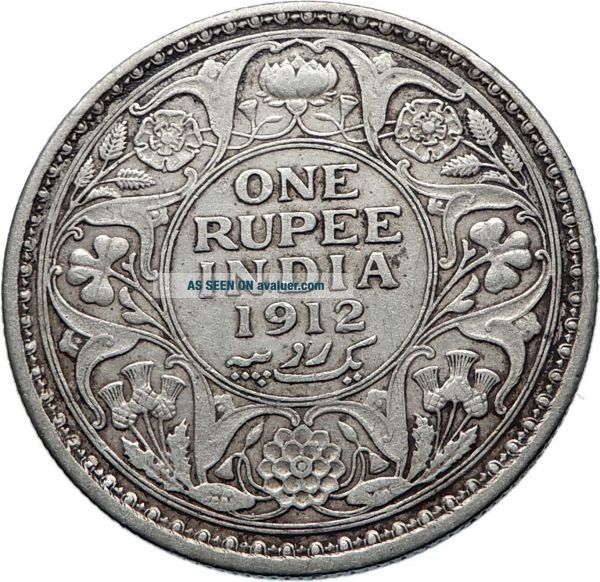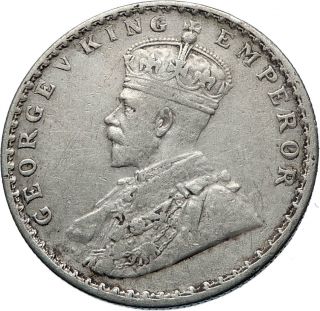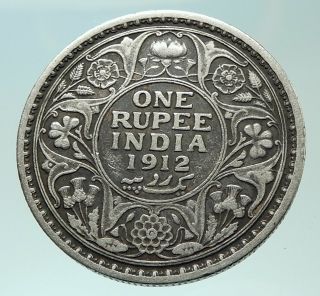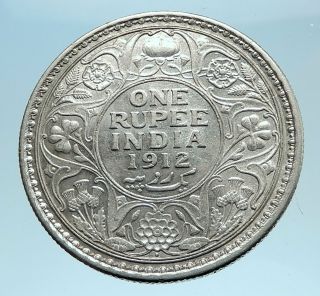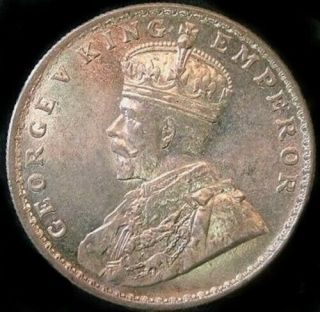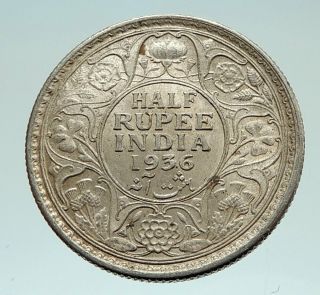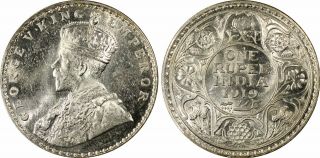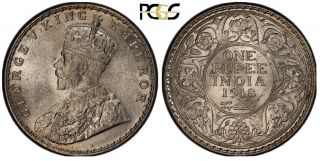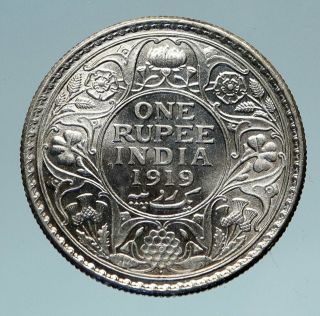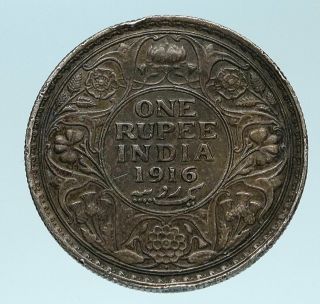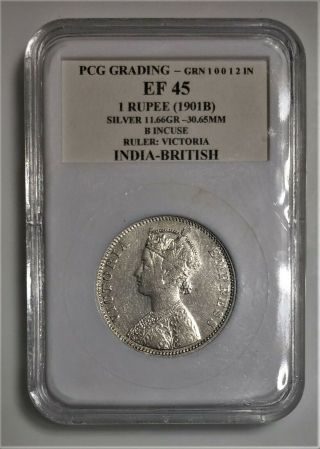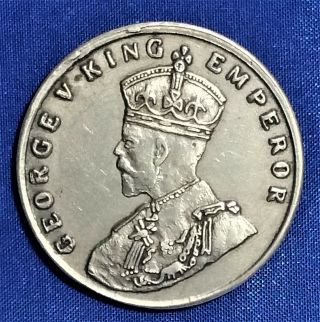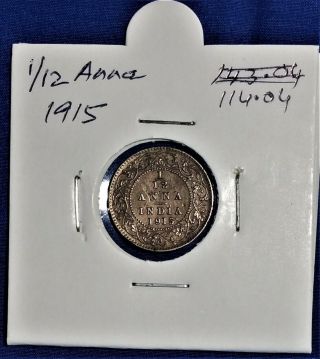1912 INDIA UK King George V Silver Antique RUPEE Vintage Indian Coin I71850
Item History & Price
| Reference Number: Avaluer:24103628 | Composition: Silver |
| Certification: Uncertified |
Authentic Coin of: India - Colonial British India - George V
1912 Silver Rupee 31mm (11.55 grams) 0.917 Silver (0.3438 oz ASW)
Reference: KM 524
GEORGE V KING EMPEROR Crowned bust of George V facing left.
ONE RUPEE INDIA, یک روپیہ Within circle, date divides legend in English & Urdu (Yek Rupya) . Outside circle, wreath made of roses, thistle, shamrock leaves and lotus flowers.You are bidding on the exact item pictured, provided with a Certi...ficate of Authenticity and Lifetime Guarantee of Authenticity. Colonial India is the part of the Indian subcontinent which was under the control of European colonial powers, through trade and conquest. The first European power to arrive in India was the Macedonian army of Alexander the Great in 327-326 BC. The satraps he established in the north west of the subcontinent quickly crumbled after he left. Later, trade was carried between Indian states and the Roman Empire by Roman sailors who reached India via the Red Sea and Arabian Sea , but the Romans never sought trading settlements or territory in India. The spice trade between India and Europe was one of the main types of trade in the world economy and was the main catalyst for the period of European exploration .[1][2] The search for the wealth and prosperity of India led to the accidental "discovery" of the Americas by Christopher Columbus in 1492. Only a few years later, near the end of the 15th century, Portuguese sailor Vasco da Gama became the first European to re-establish direct trade links with India since Roman times by being the first to arrive by circumnavigating Africa (1497-1499). Having arrived in Calicut , which by then was one of the major trading ports of the eastern world, [3] he obtained permission to trade in the city from Saamoothiri Rajah .Trading rivalries brought other European powers to India. The Netherlands , England , France, and Denmark established trading posts in India in the early 17th century. As the Mughal Empire disintegrated in the early 18th century and then the Maratha Empire became weakened after the third battle of Panipat , the relatively weak and unstable Indian states which emerged were increasingly open to manipulation by the Europeans through dependent "friendly" Indian rulers.In the later 18th century Britain and France struggled for dominance through proxy Indian rulers and also by direct military intervention. The defeat of the redoubtable Indian ruler Tipu Sultan in 1799 marginalised French influence. This was followed by a rapid expansion of British power through the greater part of the subcontinent in the early 19th century. By the middle of the century, the British had already gained direct or indirect control over almost all of India. British India contained the most populous and valuable provinces of the British Empire and thus became known as "the jewel in the British crown".East India CompanySee also: Company rule in India In 1757 Mir Jafar , the commander in chief of the army of the Nawab of Bengal , along with Jagat Seth , Maharaja Krishna Nath , Umi Chand and some others, secretly connived with the British, asking support to overthrow the Nawab in return for trade grants. The British forces, whose sole duty until then was guarding Company property, were numerically inferior to the Bengali armed forces. At the Battle of Plassey on 23 June 1757, fought between the British under the command of Robert Clive and the Nawab, Mir Jafar's forces betrayed the Nawab and helped defeat him. Jafar was installed on the throne as a British subservient ruler. The battle transformed British perspective as they realised their strength and potential to conquer smaller Indian kingdoms and marked the beginning of the imperial or colonial era in the subcontinent.British policy in Asia during the 19th century was chiefly concerned with expanding and protecting its hold on India, viewed as its most important colony and the key to the rest of Asia.[9] The East India Company drove the expansion of the British Empire in Asia. The company's army had first joined forces with the Royal Navy during the Seven Years' War , and the two continued to cooperate in arenas outside India: the eviction of Napoleon from Egypt (1799), the capture of Java from the Netherlands (1811), the acquisition of Singapore (1819) and Malacca (1824), and the defeat of Burma (1826).From its base in India, the company had also been engaged in an increasingly profitable opium export trade to China since the 1730s. This trade, unlawful in China since it was outlawed by the Qing dynasty in 1729, helped reverse the trade imbalances resulting from the British imports of tea, which saw large outflows of silver from Britain to China. In 1839, the confiscation by the Chinese authorities at Canton of 20, 000 chests of opium led Britain to attack China in the First Opium War , and the seizure by Britain of the island of Hong Kong, at that time a minor settlement.[11]The British had direct or indirect control over all of present-day India before the middle of the 19th century. In 1857, a local rebellion by an army of sepoys escalated into the Rebellion of 1857 , which took six months to suppress with heavy loss of life on both sides. The trigger for the Rebellion has been a subject of controversy. The resistance, although short-lived, was triggered by British East India Company attempts to expand its control of India. According to Olson, several reasons may have triggered the Rebellion. For example, Olson concludes that the East India Company's attempt to annexe and expand its direct control of India, by arbitrary laws such as Doctrine of Lapse, combined with employment discrimination against Indians, contributed to the 1857 Rebellion.[12] The East India Company officers lived like princes, the company finances were in shambles, and the company's effectiveness in India was examined by the British crown after 1858. As a result, the East India Company lost its powers of government and British India formally came under direct British rule , with an appointed Governor-General of India . The East India Company was dissolved the following year in 1858. A few years later, Queen Victoria took the title of Empress of India.India suffered a series of serious crop failures in the late 19th century, leading to widespread famines in which at least 10 million people died. The East India Company had failed to implement any coordinated policy to deal with the famines during its period of rule.[citation needed][dubious - discuss ] This changed during the Raj , in which commissions were set up after each famine to investigate the causes and implement new policies, which took until the early 1900s to have an effect.The slow but momentous reform movement developed gradually into the Indian Independence Movement . During the years of World War I , the hitherto bourgeois "home-rule" movement was transformed into a popular mass movement by Mahatma Gandhi , a pacifist . Apart from Gandhi, other revolutionaries such as Shaheed Bhagat Singh , Chandrashekar Azad , Subhas Chandra Bose , and Pradyumn Ananth Pendyala were not against use of violence to oppose the British rule. The independence movement attained its objective with the independence of Pakistan and India on 14 and 15 August 1947 respectively.Conservative elements in England consider the independence of India to be the moment that the British Empire ceased to be a world power, following Curzon 's dictum that, "[w]hile we hold on to India, we are a first-rate power. If we lose India, we will decline to a third-rate power."George V (George Frederick Ernest Albert; 3 June 1865 - 20 January 1936) was King of the United Kingdom and the British Dominions, and Emperor of India, from 6 May 1910 until his death in 1936. He was the second son of Albert Edward, Prince of Wales (later King Edward VII), and the grandson of the reigning British monarch, Queen Victoria. From the time of his birth, he was third in the line of succession behind his father and his elder brother, Prince Albert Victor, Duke of Clarence and Avondale. From 1877 to 1891, George served in the Royal Navy, until the unexpected death of his elder brother in early 1892 put him directly in line for the throne. On the death of his grandmother in 1901, George's father became King-Emperor of the British Empire, and George was created Prince of Wales. He succeeded his father in 1910. He was the only Emperor of India to be present at his own Delhi Durbar. His reign saw the rise of socialism, communism, fascism, Irish republicanism, and the Indian independence movement, all of which radically changed the political landscape. The Parliament Act 1911 established the supremacy of the elected British House of Commons over the unelected House of Lords. As a result of the First World War (1914-18) the empires of his first cousins Tsar Nicholas II of Russia and Kaiser Wilhelm II of Germany fell while the British Empire expanded to its greatest effective extent. In 1917, George became the first monarch of the House of Windsor, which he renamed from the House of Saxe-Coburg and Gotha as a result of anti-German public sentiment. In 1924 he appointed the first Labour ministry and in 1931 the Statute of Westminster recognised the dominions of the Empire as separate, independent states within the Commonwealth of Nations. He was plagued by illness throughout much of his later reign and at his death was succeeded by his eldest son, Edward VIII. Frequently Asked Questions
Mr. Ilya Zlobin, world-renowned expert numismatist, enthusiast, author and dealer in authentic ancient Greek, ancient Roman, ancient Byzantine, world coins & more.Who am I dealing with?You are dealing with Ilya Zlobin, ancient coin expert, enthusiast, author and dealer with an online store having a selection of over 15, 000 items with great positive feedback from verified buyers and over 10 years experience dealing with over 57, 000 ancient and world coins and artifacts. Ilya Zlobin is an independent individual who has a passion for coin collecting, research and understanding the importance of the historical context and significance all coins and objects represent. Most others are only concerned with selling you, Ilya Zlobin is most interested in educating you on the subject, and providing the largest selection, most professional presentation and service for the best long-term value for collectors worldwide creating returning patrons sharing in the passion of ancient and world coin collecting for a lifetime. How long until my order is shipped?Orders are shipped by the next business day (after receipt of payment) most of the time. How will I know when the order was shipped?After your order has shipped, you will be left positive feedback, and that date could be used as a basis of estimating an arrival date. Any tracking number would be found under your 'Purchase history' tab.USPS First Class mail takes about 3-5 business days to arrive in the U.S. International shipping times cannot be estimated as they vary from country to country.Standard international mail to many countries does not include a tracking number, and can also be slow sometimes. For a tracking number and signature confirmation, you may want to do Express Mail International Shipping, which costs more, however, is the fastest and most secure. Additionally you may be able to receive your order in as little as 3-5 business days using this method. For Express Mail International, it may be possible to place up to 10-15 items in one package (for the one shipping cost) as it is flat rate envelope, which may be the most cost-effective, secure and fastest way to receive items internationally. Send me a message about this and I can update your invoice should you want this method.Getting your order to you, quickly and securely is a top priority and is taken seriously here. Great care is taken in packaging and mailing every item securely and quickly.Please be aware, I cannot take responsibility for any postal service delivery delays, especially for international packages as it may happen in rare instances.What is a certificate of authenticity and what guarantees do you give that the item is authentic?Each of the items sold here, is provided with a Certificate of Authenticity, and a Lifetime Guarantee of Authenticity, issued by a world-renowned numismatic and antique expert that has identified over 57, 000 ancient coins and has provided them with the same guarantee. You will be very happy with what you get with the COA; a professional presentation of the coin, with all of the relevant information and a picture of the coin you saw in the listing. Additionally, the coin is inside it's own protective coin flip (holder), with a 2x2 inch description of the coin matching the individual number on the COA.On the free-market such a presentation alone, can be considered a $25-$50 value all in itself, and it comes standard with your purchases from me, FREE. With every purchase, you are leveraging my many years of experience to get a more complete context and understanding of the piece of history you are getting. Whether your goal is to collect or give the item as a gift, coins presented like this could be more prized and valued higher than items that were not given such care and attention to.Buy a coin today and own a piece of history, guaranteed.Is there a money back guarantee?I offer a 30 day unconditional money back guarantee. I stand behind my coins and would be willing to exchange your order for either store credit towards other coins, or refund, minus shipping expenses, within 30 days from the receipt of your order. My goal is to have the returning customers for a lifetime, and I am so sure in my coins, their authenticity, numismatic value and beauty, I can offer such a guarantee.When should I leave feedback?Once you receive your order, please leave a positive feedback. Please don't leave any negative feedbacks, as it happens sometimes that people rush to leave feedback before letting sufficient time for their order to arrive. Also, if you sent an email, make sure to check for my reply in your messages before claiming that you didn't receive a response. The matter of fact is that any issues can be resolved, as reputation is most important to me. My goal is to provide superior products and quality of service.How and where do I learn more about collecting ancient coins?Visit the "Guide on How to Use My Store" for on an overview about using my store, with additional information and links to all other parts of my store which may include educational information on topics you are looking for.
02352



